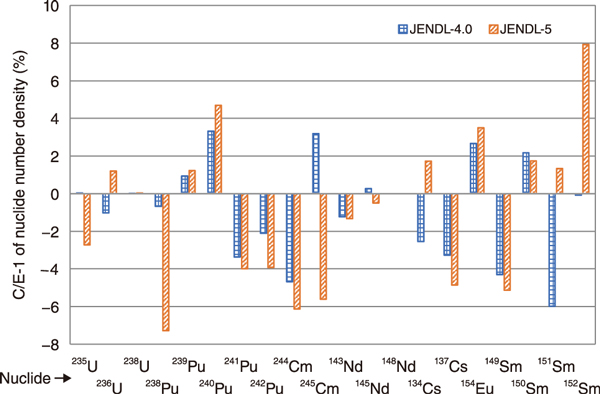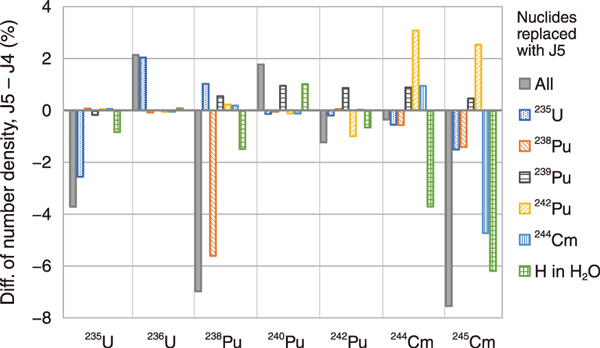
Fig.1 Comparison of the calculated and measured fuel composition for the Takahama-3 PIE sample (SF97)

Fig.2 Changes in the calculated number density by replacing the nuclear data for each nuclide
Nuclear data are important fundamental data for simulation in the fields of nuclear and radiation engineering. The latest version of the Japanese Evaluated Nuclear Data Library, JENDL-5, was published at the end of 2021. Many important nuclear data, such as neutron reaction cross sections, decay data, and fission yields, were revised from JENDL-4.0 to JENDL-5.
To use the new nuclear data for various applications, the data should be validated by comparing the simulation with experiments. One of the data available for validation is the postirradiation experiment (PIE) data. PIE data include nuclide compositions of irradiated fuels measured by various methods, including destructive analysis. The validity of the nuclear data used for the simulation can be confirmed by comparing simulated nuclide compositions with the PIE data. The PIE data can be simulated by the “depletion (burnup) calculation” for evaluating time-dependent fuel composition. The depletion calculation is a fundamental technique for reactor core designs and criticality/radiation safety evaluations of irradiated fuels. Therefore, validation of nuclear data for the depletion calculation is essential.
In the present study, JENDL-5 was validated for depletion calculations for light water reactors (LWRs). The PIE data of Takahama NPP Unit 3 (Takahama-3), which was used to validate various codes and nuclear data libraries, were analyzed using JENDL-5. Fig.1 shows the nuclide number densities calculated using the depletion calculation code Serpent 2, compared to the measurement values. The result obtained using JENDL-4.0 is also shown for comparing JENDL-4.0 and JENDL-5. According to Fig.1, the differences between the calculated and measured nuclide number densities are within several percent for both JENDL-4.0 and JENDL-5. This result indicates that JENDL-5 has sufficient accuracy for depletion calculations of LWR comparable to JENDL-4.0.
Fig.1 also shows the differences in number density for some nuclides between JENDL-4.0 and JENDL-5. For example, the C/E-1 value of 238Pu is −7% for JENDL-5, while that for JENDL-4.0 is close to zero. To clarify the reason for the differences in the number density between JENDL-4.0 and JENDL-5, we performed additional depletion calculations while replacing one nuclear data of interest from JENDL-4.0 to JENDL-5. As a part of the calculation results, Fig.2 shows the changes in calculated number densities. For example, replacing the 238Pu cross-section causes a difference of −5.8% in the 238Pu number density, which is close to the −7% difference obtained by using JENDL-5 for all nuclides. This means the 238Pu number density difference arises mainly from the update in the 238Pu cross-section.
This study validated JENDL-5 for LWR depletion calculations using PIE data and discussed the impact of the update from JENDL-4.0 to JENDL-5 on the number densities. The results of this research are expected to contribute to the promotion of JENDL-5 and to the further improvement of nuclear data.
(Tomoaki Watanabe)